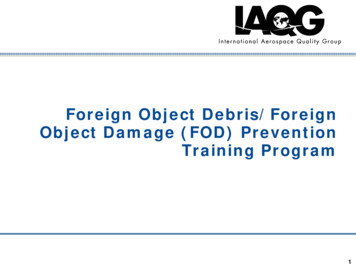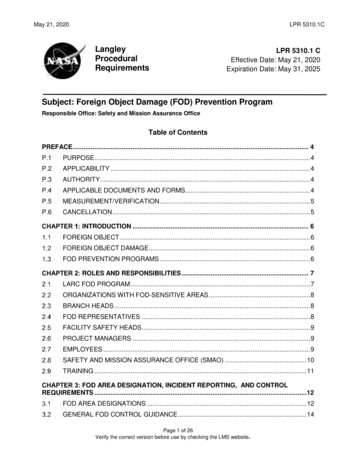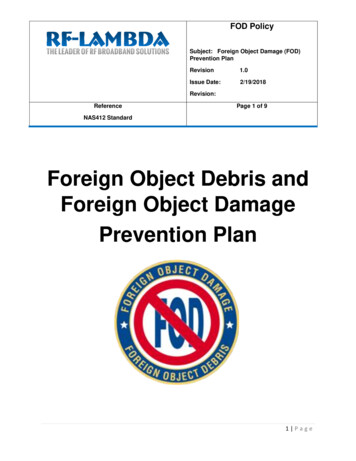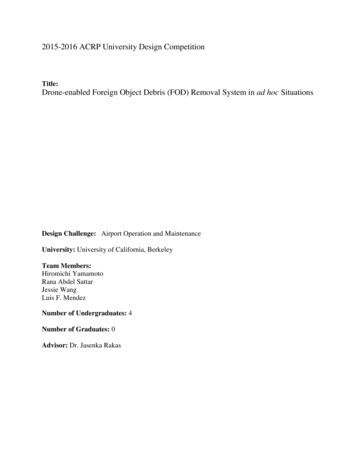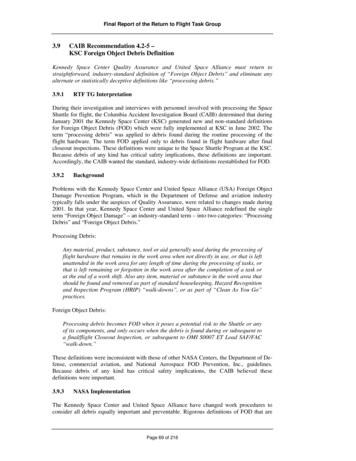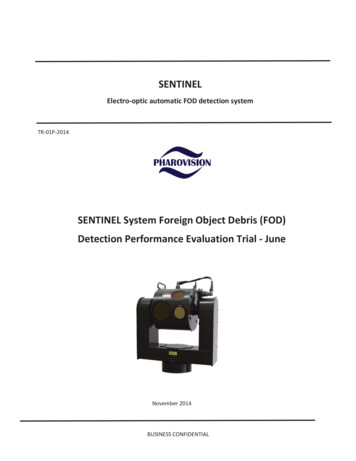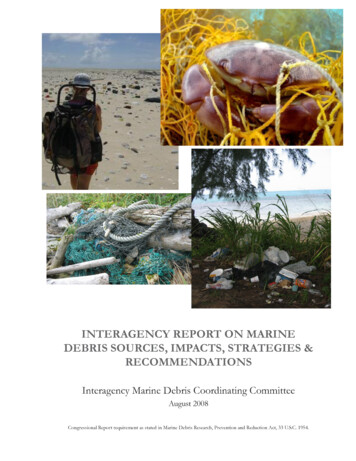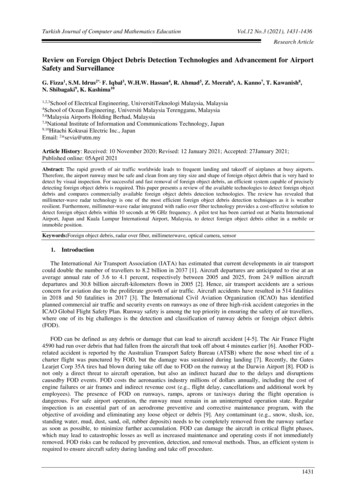
Transcription
Turkish Journal of Computer and Mathematics EducationVol.12 No.3 (2021), 1431-1436Research ArticleReview on Foreign Object Debris Detection Technologies and Advancement for AirportSafety and SurveillanceG. Fizza1, S.M. Idrus2*, F. Iqbal3, W.H.W. Hassan4, R. Ahmad5, Z. Meerah6, A. Kanno7, T. Kawanish8,N. Shibagaki9, K. Kashima101,2,3School of Electrical Engineering, UniversitiTeknologi Malaysia, MalaysiaSchool of Ocean Engineering, Universiti Malaysia Terengganu, Malaysia5,6Malaysia Airports Holding Berhad, Malaysia7,8National Institute of Information and Communications Technology, Japan9,10Hitachi Kokusai Electric Inc., JapanEmail: 2*sevia@utm.my4Article History: Received: 10 November 2020; Revised: 12 January 2021; Accepted: 27January 2021;Published online: 05April 2021Abstract: The rapid growth of air traffic worldwide leads to frequent landing and takeoff of airplanes at busy airports.Therefore, the airport runway must be safe and clean from any tiny size and shape of foreign object debris that is very hard todetect by visual inspection. For successful and fast removal of foreign object debris, an efficient system capable of preciselydetecting foreign object debris is required. This paper presents a review of the available technologies to detect foreign objectdebris and compares commercially available foreign object debris detection technologies. The review has revealed thatmillimeter-wave radar technology is one of the most efficient foreign object debris detection techniques as it is weatherresilient. Furthermore, millimeter-wave radar integrated with radio over fiber technology provides a cost-effective solution todetect foreign object debris within 10 seconds at 96 GHz frequency. A pilot test has been carried out at Narita InternationalAirport, Japan and Kuala Lumpur International Airport, Malaysia, to detect foreign object debris either in a mobile orimmobile position.Keywords:Foreign object debris, radar over fiber, millimeterwave, optical camera, sensor1.IntroductionThe International Air Transport Association (IATA) has estimated that current developments in air transportcould double the number of travellers to 8.2 billion in 2037 [1]. Aircraft departures are anticipated to rise at anaverage annual rate of 3.6 to 4.1 percent, respectively between 2005 and 2025, from 24.9 million aircraftdepartures and 30.8 billion aircraft-kilometers flown in 2005 [2]. Hence, air transport accidents are a seriousconcern for aviation due to the proliferate growth of air traffic. Aircraft accidents have resulted in 514 fatalitiesin 2018 and 50 fatalities in 2017 [3]. The International Civil Aviation Organization (ICAO) has identifiedplanned commercial air traffic and security events on runways as one of three high-risk accident categories in theICAO Global Flight Safety Plan. Runway safety is among the top priority in ensuring the safety of air travellers,where one of its big challenges is the detection and classification of runway debris or foreign object debris(FOD).FOD can be defined as any debris or damage that can lead to aircraft accident [4-5]. The Air France Flight4590 had run over debris that had fallen from the aircraft that took off about 4 minutes earlier [6]. Another FODrelated accident is reported by the Australian Transport Safety Bureau (ATSB) where the nose wheel tire of acharter flight was punctured by FOD, but the damage was sustained during landing [7]. Recently, the GatesLearjet Corp 35A tires had blown during take off due to FOD on the runway at the Darwin Airport [8]. FOD isnot only a direct threat to aircraft operation, but also an indirect hazard due to the delays and disruptionscausedby FOD events. FOD costs the aeronautics industry millions of dollars annually, including the cost ofengine failures or air frames and indirect revenue cost (e.g., flight delay, cancellations and additional work byemployees). The presence of FOD on runways, ramps, aprons or taxiways during the flight operation isdangerous. For safe airport operation, the runway must remain in an uninterrupted operation state. Regularinspection is an essential part of an aerodrome preventive and corrective maintenance program, with theobjective of avoiding and eliminating any loose object or debris [9]. Any contaminant (e.g., snow, slush, ice,standing water, mud, dust, sand, oil, rubber deposits) needs to be completely removed from the runway surfaceas soon as possible, to minimize further accumulation. FOD can damage the aircraft in critical flight phases,which may lead to catastrophic losses as well as increased maintenance and operating costs if not immediatelyremoved. FOD risks can be reduced by prevention, detection, and removal methods. Thus, an efficient system isrequired to ensure aircraft safety during landing and take off procedure.1431
G. Fizza, S. M. Idrus*, F. Iqbal, W.H.W. Hassan, R. Ahmad, Z. Meerah,A. Kanno, T. Kawanish, N. Shibagaki, K. KashimaThis paper presents a review on FOD detection methods and advancement on FOD technologies for airportsafety and surveillance. This paper further divided into four sections. Section II describes the conventional FODdetection methods and section III covers automated detection methods. In section IV, FOD detection techniquesused by airports are discussed. Finally, section V concludes the paper.2.Conventional Detection MethodRunway inspection is usually conducted by visual patrol via vehicles on the runway surface to find andremove any detected FOD, depending on runway availability and operation type. Its may be necessary to hirededicated personnel to continuously check for FOD, if the presence of any ongoing construction activities.Manual FOD removal is usually sufficient, though special removal equipment is available and suitable for airportoperations. Table 1 shows some examples of mechanical and non-mechanical FOD removal equipment.Table 1. FOD Removal Equipment[10]MechanicalNon MechanicalPowerSweepersFriction MatSweepersVacuumSystemsMagnetic Bars(attached to vehicles)Jet Air BlowersRumble strips (also FOD Shakers)Mechanical equipment use powered equipment to remove, retrieve or contain FOD for proper disposal, wherethe equipment size can vary from small thrust units to large scale truck-mounted systems. Non-mechanicalequipment need not be powered, e.g., sweepers, magnetic bars and rumble strips. Although FOD removalequipment has been used in the past, their effectiveness in removing deposits from tires or vehicle undercarriagesis often negligible, and the equipment itself can produce FOD if not regularly cleaned. The current best practicefor removing tire based FOD is by visually inspecting vehicles at a designated checkpoint and manually removeany detected debris with a hand tool.3.Automated Detection MethodIt can be challenging to pinpoint the exact location of any FOD by visual patrol, and manual visual patrol canalso be time-consuming. Therefore, more advanced automated methods to detect FOD with higher accuracy isneeded [10]. The comparison between manual and automated detection methods is mentioned in Table 2.Automated FOD detection system can perform 24/7 inspection and detection, avoiding flight delays and runwayclosures, with clear visibility even at night time and the ability to operate in all weather conditions [11].Automated detection techniques can be classified into four categories, namely the ultrasonic sensors, cameradetection, radar detection and hybrid detection methods, as shown in Figure 1. A general comparison betweenFOD detection techniques with respect to resolution and coverage area can be illustrated. Higher resolution andwide coverage areas play a vital role in the design of any FOD detection system. A brief overview of the existingsystem has been described in the following sections.Table 2. Comparison between Detection ction 24/7NoYesFOD detection using visual inspection prone to errorsYesNoNighttime inspectionNoYesPossibility of FODinspectionsundetectedYesNoRequire more personsYesNoDetection of tiny objectsNoYes1432
Review on Foreign Object Debris Detection Technologies and Advancement for Airport Safety and SurveillanceFigure 1. Resolution and Coverage area of Existing FODD system3.1. Ultrasonic SensorSystemTo sense the environment and security systems are the most significant technologies,ultrasonic sensing is oneof the ways to sense proximity and detect levels with high reliability and low cost [12-14]. A rover equippedwith Light Detection and Ranging (LiDAR) technology and 40 kHz ultrasonic sensors is proposed in [15], wherethe rover is controlled by Bluetooth android application. LiDAR uses light to scan the path to detect any FODand calculate the time for the return signal [16]. The proposed system can detect FODs of different sizes withgood location accuracy, and the location is shared with the operator, albeit without visual information.3.2. Camera DetectionSystemEfficient visualization of interference and debris is important to prevent further dangers. For the detection ofrunway incursion, cracking and obstacles, electro-optical color images and infrared sensor on board the aircrafthas been proposed in [17], Image processing techniques have been utilized for detecting FOD andcharacterizingthe pavement distress,e.g., [18]proposed a video-based FOD detection setup via a single camera sensor installedon the runway at Nanyang International Airport, where image change algorithm is used to successfully detectFOD of 4cm in size [19].Machine vision is another approach used for runway identification. However, cameradetection systems do face visibility difficulties due to weather conditions, fog and darkness.3.3. Radar DetectionSystemRadar is widely used in public safety and defense as the primary means of detection and surveillance. Aminiature radar system with very high resolution is desirable to locate FOD at high precision under all weatherconditions.Radar can cover a wide area compared to ultrasonic sensors and lasers. The millimeter-wavetechnology is a suitable candidate for high-resolution FOD detection [20]since the millimeter-wave radar canoperate under both day and night conditions and is very adaptable to bad weather conditions. Millimeter-waveradars have high positioning, sensitivity to small FODs and accuracy in terms of distance and angle,e.g., usingFrequency Modulated Continuous Wave (FMCW) radar at millimeter-wave frequencies.FMCW radar has beenused to achieve high resolution at 73-80 GHz and 94-95 GHz [18].3.4.Hybrid Detection SystemsThe advantages of the radar in shape detection and image in appearance detection have to lead to a hybriddetection system, e.g., using millimeter-wave radar with infrared image sensors [21].Another technique fordetecting runway incursion and obstacles, electro-optical color images and an infrared sensor onboard the aircraftis proposed with significant results in day/night and low visibility condition.FOD’s visibility and detection havebeen improved using Radio over Fiber (RoF) technology [22-23].4. Commercially Available Latest Fod Detection System1433
G. Fizza, S. M. Idrus*, F. Iqbal, W.H.W. Hassan, R. Ahmad, Z. Meerah,A. Kanno, T. Kawanish, N. Shibagaki, K. KashimaExamples of existing FOD detection systems are Tarsier millimeter-wave radar, hybrid electro-opticalmillimeter-wave radar with a video camera,intelligent high-resolution cameraand mobile vehicle-mountedmillimeter-wave radar.These four FOD detection systems have been tested and approved by the Federal AviationAdministration (FAA). These systems reported are capable of improved runway safety; however,the relativelyrequire high investments [24].General comparison of the system capability is shown in Table 3, includingmillimeter-wave radar over fiber FOD detection system manufactured by Hitachi Kokusai Electric fromJapan[25].Operating millimeter-wave radar for FOD detection is favorable due to its weather-resistant properties.While installing and maintaining the linear cell FOD detection system utilizing RoF integrated with FMCWradar does not require runway closure, it can be considered the most practical and cost-effective solution for thebusy airport.The Hitachi’s FOD detection system has been installed and currently under field trial at NaritaInternational Airport (NIA) Japan and Kuala Lumpur International Airport (KLIA) Malaysia.The high precision FODDS consists of 96 GHz frequency radars supported with high-resolution opticalcameras to ensure high-quality images, real-time data collection, expediting the investigation process inidentifying FOD sources and facilitating fast runway clearing. The specification of the FOD detection system islisted in Table 4 [25].Figure 2 illustrates the concept of radar over the fiber FOD detection system.The radars along the runway areconnected to the airport operation center through the optical fiber cables which are installed in the runway area.The optical frequency modulated continuous wave signals are generated by the optical source and electricalsignals at the control center and are optically amplified and distributed via the optical divider to radars. Thecontrol center receives the signals from each radar, and the signals are processed, displayed and stored in theserver at the monitoring center.Table 3. Comparison between implemented FOD detection Systems. [24]ProductTechnologyFrequencyMax Range(Manufacturer)FODetectmmWave radar with 77 GHz50 m(Xsight System)optical cameraMoog TarsiermmWave radar94 GHz1500 m(Qinetiq)iFerretoptical camera–(Stratech)FOD finderMobilemmWave 78 – 81 GHz140 m(Trex Enterprises)radarFODdetection mmWave radar over 92 – 100 GHz 500 mSystemfiberwithHD(HitachiCameraKokusai Electric)Figure 2.Radar over fiber FOD detection systemTable 4. Specification of FODD system using RoF1434RangeResolution-SystemThroughput4 min30 cm72 sec-70 sec-45 sec 3 cm10 sec
Review on Foreign Object Debris Detection Technologies and Advancement for Airport Safety and ainDetectionrangeHDcamera96GHz42dB500mImage sensor 1/2.8 3MOS,zoom ratio x25(F.14) OpticalFiberSingle Mode, Wavelength 1310-1500nmThe above FOD detection system is able to detect FOD samples of various sizes, shapes and material at 96GHz, up to 500 m range from radar head during the clear sky and 200 m under 20 mm/h rainfall. Under 20 mm/hrainfall, it was observed that some scattering appears in the reading due to rain puddles around the FOD. Thesmallest FOD detected so far during the field trial at KLIA runway is a 1 cm asphalt. The FOD detection systemcan detect very small FOD with high accuracy within 10 seconds, whereas other detection systems generallyhave a response time of more than 45 seconds. The linear cell FOD detection system installed at KLIA Malaysiaand NIA Japan is capable of rapid alert by radar sensing with high accuracy while aircrafts takeoff or landing.5.ConclusionThis paper reviewed FOD detection techniques for airport runways. An automated system is expected toreplace regular manual inspection four times a day (as required by ICAO). In return, the airport operation’sefficiency is maximized since there is no interruption from airport closure due to FOD inspection. Among all thereviewed automated FOD systems, it is found that the millimeter-wave radar technique is the most promisingsolution. The pilot test using this technique at the KLIA airport has shown promising outcomes. The systemnamed high precision FOD detection system is operated with 96 GHz mm-wave radar integrated with a highresolution optical camera, resulting in a high quality of image detected and real-time data collection. Theinvestigation period to identify the FOD source is significantly minimized and consequentially increase thespeed’s runway clearing process. Thus, a safer airport runway environment is established with the optimizedrecourses, and the real-time operation of the airport runaways is maximized.6. AcknowledgementsThis work is conducted as a part of a collaborative project entitled “FODDS Field Trial at KLIA” funded bythe Ministry of Internal Affairs and Communications, Japan, and UniversitiTeknologi Malaysia Internal Grantvote 01M62. The authors would like to thanks UniversitiTeknologi Malaysia (UTM), Malaysia Airport HoldingBerhad, Hitachi Kokusai Electric, Waseda University, NICT Japan, ENRI Japan and iSmartUrusSdnBhd for theircooperation in the field experiments.References1.IATA Forecast Predicts 8.2 billion Air Travelers in 2037, International Air TransportAssociation(IATA),Press Release No. 62,Date: 24 October 2018.2. Crucial Meausure for Reducing the CFIT Risk,International Civil Aviation Organization (ICAO)Journal,vol. 62, no. 2,March/April 2007.3. Safety Report, International Civil Aviation Organization (ICAO), Edition 2018.4. State of Global Aviation Safety,International Civil Aviation Organization (ICAO) safety report,Edition2019.5. Foreign Object Debris (FOD) detection research,International Airport Review,Issue 2,2008.6. Concorde crash kills 113,BBC News,July, 2000.7. Foreign object debris involving Piper PA-31, Palm Island, Qld,Australian Transport Safety Bureau(ATSB),AB-2018-13,27 November 2018.8. Foreign object debris involving a Gates Learjet Corp 35A, Darwin, NT,Australian Transport SafetyBureau (ATSB),No.AB-2019-005, 3 February 20199. International Standards and Recommended Practices,Annex 14 to the Convention on International CivilAviation Aerodromes,Volume I,Aerodrome Design and Operations,Eighth Edition, July 2018.10. Alathari, Bashar, Mohammed Falih Kadhim, Salam Al-Khammasi, and Nabeel Salih Ali. “A frameworkimplementation of surveillance tracking system based on PIR motion sensors.” Indonesian Journal ofElectrical Engineering and Computer Science 13, no. 1 (2019): 235-242.1435
G. Fizza, S. M. Idrus*, F. Iqbal, W.H.W. Hassan, R. Ahmad, Z. Meerah,A. Kanno, T. Kawanish, N. Shibagaki, K. Kashima11. Khairi, Mohd Taufiq Mohd, Sallehuddin Ibrahim, Mohd Amri Md Yunus, and Ahmad Ridhwan Wahap.“Detection of foreign objects in milk using an ultrasonic system.” Indonesian Journal of ElectricalEngineering and Computer Science 15, no. 3 (2019): 1241-1249.12. Khan, Talha, Muhammad Alam, Kushairy Kadir, Zeeshan Shahid, M. S. Mazliham, Sheroz Khan, andMohammad Miqdad. ”Recognizing Foreign Object Debris (FOD): False Alarm ReductionImplementation.” Indonesian Journal of Electrical Engineering and Computer Science 11, no. 1 (2018):41-46.13. Elrayes, Ahmed, Mohamed Hag Ali, Amer Zakaria, and Mahmoud H. Ismail. “Smart airport foreignobject debris detection rover using LiDAR technology.” Internet of Things 5 (2019): 1-1114. Christian, John A., and Scott Cryan. ”A survey of LIDAR technology and its use in spacecraft relativenavigation.” In AIAA Guidance, Navigation, and Control Conference, p. 4641. 2013.15. National Academies of Sciences, Engineering, and Medicine. 2011. Current Airport InspectionPractices Regarding FOD (Foreign Object Debris/Damage). Washington, DC: The National AcademiesPress.16. N. Yamamoto, T. Umezawa, A. Kanno, K. Akahane, and T. Kawanishi, “High-speed photonic devicetechnologies in optical fiber connected millimeter-wave radar system for foreign object debris detectionon runways,” in 2014 XXXIth URSI General Assembly and Scientific Symposium (URSI GASS),2014, pp. 1-4: IEEE.17. Qunyu, Xu, Ning Huansheng, and Chen Weishi. “Video-based foreign object debris detection.” In 2009IEEE International Workshop on Imaging Systems and Techniques, pp. 119-122. IEEE, 2009.18. Ibrahim, A., M. K. Osman, N. A. M. Yusof, K. A. Ahmad, N. H. Harun, and R. A. A. Raof.“Characterization of cracking in pavement distress using image processing techniques and k-Nearestneighbour.” Indonesian Journal of Electrical Engineering and Computer Science 14, no. 2 (2019): 810.19. Kawanishi, Tetsuya, Atsushi Kanno, Pham Tien Dat, Toshimasa Umezawa, and Naokatsu Yamamoto.“Photonic Systems and Devices for Linear Cell Radar.” Applied Sciences 9, no. 3 (2019): 554.20. Yonemoto, Naruto, Akiko Kohmura, Shunichi Futatsumori, Tetsuji Uebo, and Alexandre Saillard.“Broad band RF module of millimeter wave radar network for airport FOD detection system.” In 2009International Radar Conference” Surveillance for a Safer World”(RADAR 2009), pp. 1-4. IEEE, 2009.21. Vegula, Satish Kumar, Sudesh K. Kashyap, and N. Shanthakumar. ” detection of runway and obstaclesusing electro-optical and infrared sensors before landing.” Defence Science Journal 64, no. 1 (2014):67-76.22. Futatsumori, Shunichi, Kazuyuki Morioka, Akiko Kohmura, Kunio Okada, and Naruto Yonemoto.”Design and field feasibility evaluation of distributed-type 96 GHz FMCW millimeter- wave radarbased on radio-over-fiber and optical frequency multiplier.” Journal of Lightwave Technology 34, no.20 (2016): 4835-4843.23. Husaini, M. M. H., C. B. M. Rashidi, S. N. Azemi, S. A. Aljunid, and M. S. Anuar. “Optical millimeterwave generation utilizing stimulated brillouin scattering for radio over fiber system.” IndonesianJournal of Electrical Engineering and Computer Science 13, no. 2 (2019): 818-824.24. Foreign Object Debris,Assembly-37th Session,Agenda Item 30: Runway Safety, Working paper, A37WP/191 TE/106,International Civil Aviation Organization (ICAO), September 2010.25. Idrus, S. M., F. Iqbal, A. Kanno, K. Akama, T. Kawanishi, N. Zulkifli, A. Ramli et al. ”Demonstrationof 95 GHz Single RAU Linear Cell Radar Over Fiber and Radar Propagation Study in Malaysia.” In2018 Progress in Electromagnetics Research.1436
ICAO Global Flight Safety Plan. Runway safety is among the top priority in ensuring the safety of air travellers, where one of its big challenges is the detection and classification of runway debris or foreign object debris (FOD). FOD can be defined as any debris or damage that can lead to aircraft accident [4-5]. The Air France Flight
